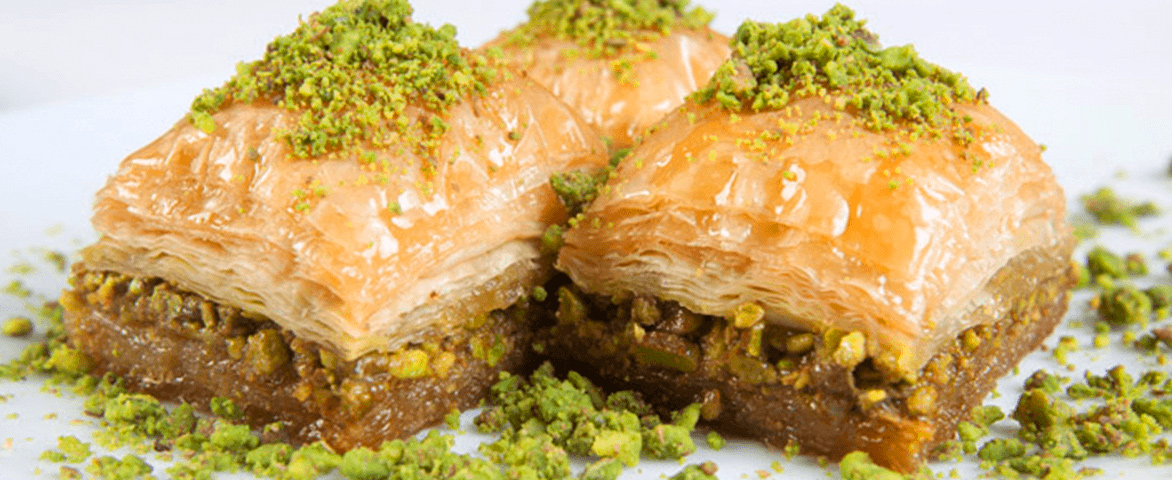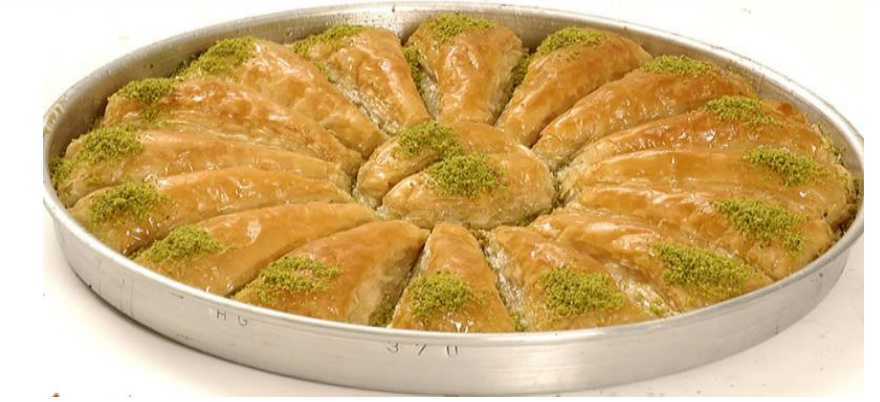There are countless secrets of baklava

Original Gaziantep Baklava differs from other baklava by the way of being made and by its taste. The most important feature that reveals this difference is the ingredients. There are countless secrets of baklava. Good baklava starts in the soil. Flour used to make the dough; the type of wheat that the flour is made from; the soil that the wheat grows are all important features.
Original Gaziantep baklava, if fresh, also gives a rustling sound to the ears in the first bite. This rust, similar to the one in which the dry leaves are out in the wind, stems from the successive breaks of fried thin sheets of yufkas, and is as delightful as the baklava itself for baklava lovers.
Many details such as the diet of the animal that milk comes from, whether it is fed with spring herbs or not, and so the quality of the butter, as well as the harvest time of the pistachio determine the flavor of the baklava. A good baklava maker picks the best of all ingredients such as pistachios, butter, flour, sugar, starch and milk. In the hands of great masters of Gaziantep the dough is turned into yufkas, each of which is thinner than a sheet of paper, with a rolling pin made of pear trees. These yufkas are so incredibly thin that when you lift them up, you can clearly see the face of the person on the opposite side.

Its history goes back to the Assyrians
The baklava, which is registered as a Turkish dessert in 2013 by the EU Commission, has so far been owned by many nations. The first accounts concerning the history of baklava goes back to the Assyrians. It is presumed that the baking of the dried fruits, scattered between two doughs, was the first form of baklava. The first record of a baklava-like dessert is found in a cookbook from 1330s, Chinese Yuan (Mongolian) dynasty. The name of the dessert described in the book implies the rose pudding and probably the rose pudding we know today. Nomadic Turks used plates, instead of ovens, which were easily carried on horseback. Instead of bread, they were eating yufka baked on these plates. The walnut, which is abundant in Central Asia, put between these thin slices of yufkas led the history of walnut-baklava.
Tracing baklava’s origin…
The word “baklava”, which is used in the same way in almost all languages today, is mentioned as “baklagu, baklagi” in Old Turkish. One of the researchers of the origin of baklava is Charles Perry, a food historian from the Los Angeles Times. Perry had come several times to Turkey and especially to Gaziantep, to investigate the history of baklava. He has written a four-page article about baklava for the newspaper. Perry also explained that the baklava belongs to the Turks at the World Food Prize Symposium in Italy, in 2001. In his argument, he used the etymology of the words related to baklava. He said that the word “yufka”, which means thin, derives from the word “yubka” once used in Central Asia.
The flavor beyond oceans…
The kind of baklava we know today is first seen in Damascus. How it is spread from Damascus to Gaziantep, and from Gaziantep to the other cities of Anatolia, is a matter of discussion. But everyone agrees on the fact that baklava took its modern form in Ottoman Palace Cuisine. Baklava is among the most preferred desserts not only in Turkey but also in the Arabian Peninsula, Greece, Albania, Macedonia, India, Afghanistan and Armenia. Texas state of the United States is another popular place for baklava today. The baklava, which was brought to the USA by the Czechs in the 19th century, entered the literature as ‘Texas Baklava’. However, there is a significant difference between the baklava made in all these countries and that of Turkey: the fineness of yufkas. In other countries, baked sheets of dough called “phyllo” are used to make the baklava, which are thicker than actual yufka used for Turkish Baklava.
BAKLAVA PROCESSION
During the reign of Sultan Süleyman the Magnificent, the soldiers were served plenty of pilaf and stew alongside zerde (a saffron and rice dessert) before the war. However, this tradition has turned into the handing out baklava in Ramadan in the late 17th century as they do not make sail often. Professor Dr. İlber Ortaylı explains this tradition as follows: “In the middle of the month of Ramadan, the sultan, as the caliph of the Muslims, visits the Cardigan-i-Sharif and sacred relics. After that, Cardigan-i-Sharif procession is organized. After this ceremony, which is predominantly religious, trays of baklava prepared in the palace cuisine and wrapped in futas (silk cloth) are lined up in front of Matbah-ı Âmire. A tray of baklava falls to every ten of the janissaries, sipahis, artillery corps and armorers. After Silahtar Aga (head armorer) having received the first of the trays on behalf of the sultan who is the head of the janissaries, each two soldiers regularly take a tray of baklava wrapped in futa. Each section comes out of the door, with superiors such as master, saka and trustee in forefront, baklava trays and bearers behind. The baklava procession parades to the barracks through Divanyolu among the applauses of the people in rows. Trays and futas were returned the next day.
Note: If walnuts are used instead of peanuts in the baklava, it is called baklava with walnuts, if peanuts or walnuts are not added and cream is not added, dry baklava, if it is cut into squares according to the cut shape, square baklava, rectangular baklava if it is cut rectangular, and carrot slice if it is cut like a carrot slice.

How Do We Understand The Best Baklava?
A good baklava can be understood with five senses.
Test by looking
You can understand the good baklava from the way it looks on the tray. Well cooked baklava shines like gold. Old master cooks call it 24 karat gold. Besides baklava should have a fresh look and be savory.
If there is too much sorbet left on the tray where some baklava is removed, it might be that they have put more sugar than needed to make it weigh heavier. For a good baklava the sorbet must be balanced so as not to make the baklava heavier in kilo and make baklava more sugary than needed.
Hearing Test
When you place a fork into a baklava you should hear a rustling sound. This means that the thin layers of dough are really thin and baklava is well cooked. The thinner the layers of dough the better the baklava.
Smelling test
When you lift to your mouth, you must smell the butter and the nut or peanut used as a filling. A good baklava should have good ingredients.
Tasting test
You can feel the good baklava in your mouth. Good baklava leaves a heavenly taste in your mouth and does not hurt the stomach.
